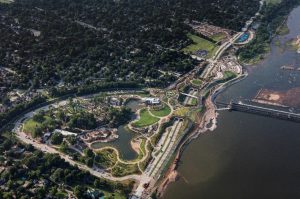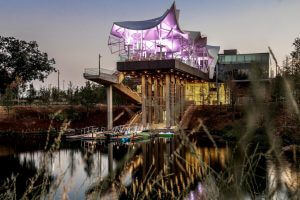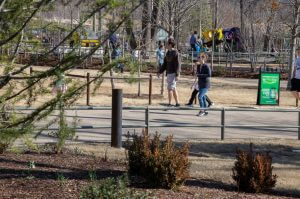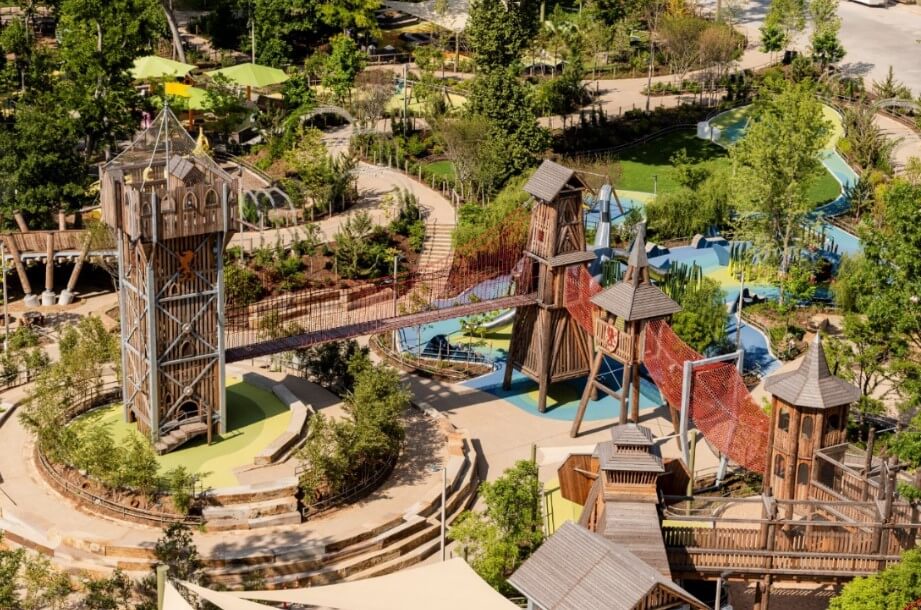Note: This article was originally published in the November edition of Parks and Rec Business magazine and on their blog. The article is authored by Russell Cobb (writer at This Land and Assistant Professor at the University of Alberta) and Matt Ainsley (Eco-Counter).
Gathering Place – A Data-Driven Park
Gathering Place is a world-class, open space park on the banks of the Arkansas River in Tulsa, Oklahoma. The 66.5-acre park is designed to “welcome all Tulsans to a vibrant and inclusive space that engages, educates and excites.” The park, which will total 100 acres once the final phase is developed, exists in large thanks to $465m in donations from the George Kaiser Family Foundation (GKFF), the City of Tulsa and 80 other donors – representing the largest gift to a community park in the history of the United States.
Following a competition that attracted proposals from top landscape architecture firms worldwide, Gathering Place’s design was undertaken by Michael Van Valkenburgh Associates (MVVA), the firm behind Teardrop Park, Brooklyn Bridge Park, the Highline and countless other high-profile projects. MVVA knew it was embarking on a transformative urban space that would reshape the identity of a city – a city previously lacking a central commons.

The 66.5-acre Gathering Place park from above Courtesy: Alex S. MacLean, Gathering Place
It’s hard to know where to begin when describing the Gathering Place – the infrastructure of the public park itself is unlike anything in this part of the country. A main north-south artery through Tulsa, Riverside Drive funnels traffic under landbridges. Berms shield the park from traffic, making the land bridge feel less like tunnels and more like natural landscapes. A main draw of the park is the Williams Lodge. The Lodge functions as a living room for the city, with two fireplaces and comfortable furniture where visitors can find some rest from Tulsa’s extreme heat and cold.
Down from the lodge is a pond with a sandy beach and wooden deck with dozens of lounge chairs. Interconnected pathways go from koi ponds to lily pad gardens to a main water feature that shoots water above and around visitors. Playgrounds are divided up into seven areas, each designed for a different age group. The area for babies and toddlers has a staff of child development professionals. River Giants, for bigger kids, has equipment produced by the Danish firm, Monstrum.

It’s hard to say whether The Boathouse is more beautiful by day, or by night Courtesy: Shane Bevel (shanebevel.com , [email protected])
Gathering Place has succeeded beyond expectations. Opening weekend celebrations in September 2018 drew more than 50,000 visitors and in the first month of operations, more than 300,000 people visited the park. Less than a year in existence, the park has become a cornerstone in the rebirth of Tulsa and the world is starting to take notice. In January, the park won the USA Today Readers’ Choice award for Best New Attraction in the United States. This summer, Time Magazine featured Gathering Place on their list of 2019 ‘World’s Greatest Places’.
Core among the park’s innovations is the management of data collected from visitors. Until recently, urban parks relied on guesswork, manual counts, or surveys to capture park visitation trends – a patchwork of often inaccurate data that is insufficient to adequately inform park planning. In developing the park, Gathering Place partnered with Eco-Counter, a company that develops and manufactures automated people counters. Eco-Counter installed thirteen pedestrian and cyclist counters at strategic locations around the park to capture usage trends, inform maintenance and security practices and support marketing storytelling. Working with MVVA’s strict landscape design standards, the discreet sensors were installed in bespoke posts, custom built in order to blend into the surrounding natural environment. Using a fleet of advanced data, Ethernet-connected ComEth data loggers, people count data is transmitted in real-time to Gathering Place’s servers, providing park managers with an on-the-ground understanding of how the park is being used at any moment of the day.

Eco-Counter PYRO people counters were installed in custom posts to blend into the surrounding environment, adhering to MVVA’s strict landscape design standards. Courtesy: Eco-Counter
This data-driven approach to park planning and management is part of a growing trend in the industry. JF Rheault, Director of Eco-Counter’s North America operations stated that count data provides an objective basis for making decisions about the future of programming. “Today, the expectations on park managers are higher,” Rheault said. “Data, in particular count data, supports better decision-making and provides an unbiased foundation for discussion with stakeholders, communicating with the public, and sharing success stories.”
In working side-by-side with Gathering Place, Eco-Counter drew on their extensive experience with parks around the world, including Singapore’s Gardens by the Bay. Much like Gathering Place, Gardens by the Bay is a flagship, interactive, inclusive and data-driven park which aimed to have – and has already had – a long-lasting socio-economic impact on the city. Across the 250-acre urban park, a network of more than thirty people counters provides a constant feed of data for managers. Park managers noticed that Gardens by the Bay saw a nearly 40% increase in weekend visitation, as well as a spike during mid-summer. With this data, park managers responded by scaling up operations to meet visitation demand and ensure the best possible experience for all guests.
At Gathering Place, data is deployed to ensure the security of guests. The park maintains a fixed opening and closing time and uses the Eco-Counters to track when guests have left the property. With people counters in place at exits and entrances, park managers ensure that visitors are leaving the area at closing time and are able to deploy resources and adapt their strategy accordingly.

Automated people counters, such as the Eco-Counter PYRO above, are integral to Gathering Place’s data-driven park management. Courtesy: Eco-Counter
In the coming months, Gathering Place will install digital wayfinding kiosks at key junctions. In addition to being provided useful site information, visitors will be asked to take a short survey to collect demographic and socio-economic information. Analyzing this data in combination with visitor count data, Gathering Place managers can get a better understanding of who is visiting the park and, more importantly, hone their message of inclusion to appeal to groups that are not. Katie Bullock, the park’s VP of Marketing, says that this multi-source, data-driven strategy will help the park, “find ways to improve, see where our gaps are, see what groups we could reach differently, and do better.”

The magnificent Adventure Playground, from above Courtesy: Shane Bevel (shanebevel.com , [email protected])
Park managers also communicate visitation data with the local Chamber of Commerce in order to promote the city to new businesses, in addition to working with local tourism agencies to justify and develop event programming. In this sense, the park is not just a local and tourist hotspot but equally serves as a way to attract and retain talent in a city. Katie Bullock passionately describes this data as pivotal to her role in promoting the park, explaining that “…data allows us to tell the story of Tulsa, and it is one of the greatest stories Tulsa will ever tell.” To this end, the data is a justifier, a promoter and a storyteller not just of Gathering Place, but of the wider region’s future overall.
More than a park, Gathering Place is a community center, a public-private partnership, an oasis of nature, and a hub for tourism. The park boasts cutting-edge playground equipment, relies on a vast quantity of data, applies a reactive strategy rooted in a deep philosophy of being the best it can be – a beacon of hope for park users, residents of Tulsa and the region overall. As the park continues to evolve, it is clear that Tulsa’s Gathering Place has established itself as a model vision of a 21st century public commons.
Cover image source: Shane Bevel (shanebevel.com , [email protected])







Il n'y a pas encore de commentaires